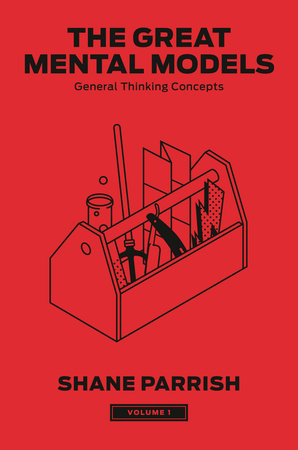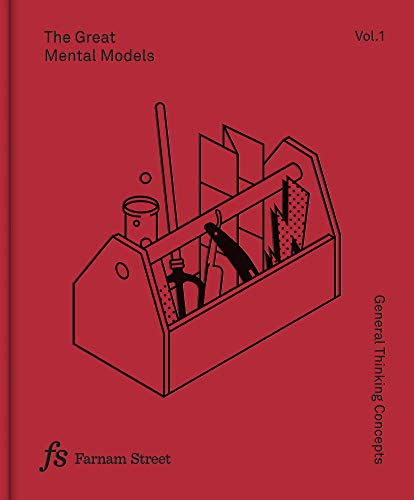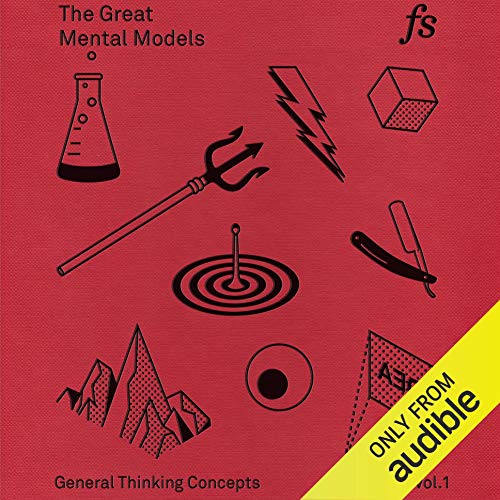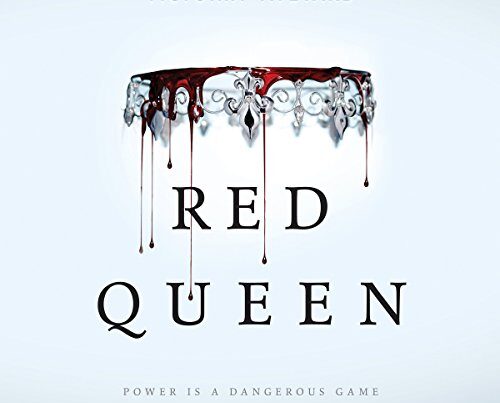Shane Parrish’s “The Great Mental Models Volume 1” Audiobook presents essential thinking tools to improve decision-making and problem-solving. It covers foundational concepts from various disciplines.
Shane Parrish is renowned for his insights into decision-making and critical thinking. His audiobook, “The Great Mental Models Volume 1,” distills complex concepts into accessible, practical tools. These mental models help individuals navigate challenges and make better decisions. Covering a range of disciplines, the book provides a comprehensive framework for understanding the world.
Listeners gain valuable strategies to enhance their cognitive toolkit. This makes it an invaluable resource for anyone looking to sharpen their analytical skills. Embrace this audiobook to elevate your thinking and approach problems with greater clarity and effectiveness.
Introduction To Shane Parrish And The Concept Of Mental Models
Shane Parrish is a name that resonates with those who pursue knowledge and wisdom. His audiobook, The Great Mental Models Volume 1, introduces the idea of mental models. These models help us understand and navigate the world more effectively.
The Genesis Of ‘the Great Mental Models’
The idea for The Great Mental Models series came from Parrish’s quest for understanding. He wanted to create a guide to help people think better. The first volume focuses on fundamental mental models that apply across various disciplines.
Parrish’s approach combines wisdom from different fields. This makes the book unique and comprehensive. The audiobook format adds an engaging layer, making it accessible to many listeners.
Who Is Shane Parrish?
Shane Parrish is the founder of the Farnam Street blog. This blog focuses on mastering the best of what other people have already figured out. Parrish has a background in cybersecurity and intelligence, adding depth to his insights.
He is known for his deep dives into mental models and decision-making. His work helps people think more clearly and make better choices. The audiobook is a natural extension of his mission to share wisdom.
| Feature | Description |
|---|---|
| Author | Shane Parrish |
| Focus | Mental Models |
| Format | Audiobook |
| Volume | 1 |
The audiobook covers a range of essential mental models. These models include concepts like first principles and the map is not the territory. Each model is explained in simple terms, making it easy to understand and apply.
- First Principles: Break down complex problems into basic elements.
- Map is Not Territory: Understand that models are simplifications.
- Second-Order Thinking: Consider the long-term consequences of actions.
Shane Parrish’s audiobook is a treasure trove of wisdom. It offers practical insights that can improve your thinking and decision-making skills.

The Power Of Mental Models In Decision-making
The audiobook “The Great Mental Models Volume 1” by Shane Parrish explores how mental models can enhance decision-making. These cognitive tools can transform how we perceive and solve problems. Using mental models helps us make better choices and avoid common pitfalls.
Why Mental Models Matter
Mental models are simple representations of how things work. They allow us to simplify complex problems. When we use mental models, we can see patterns and connections. This helps us make smarter decisions.
Mental models are important because they give us a framework. With this framework, we can understand the world better. We can make sense of new information quickly. This is crucial for effective decision-making.
Cognitive Tools For Better Judgement
Mental models serve as cognitive tools. They guide our thinking and improve our judgment. Here are some key mental models from Shane Parrish’s audiobook:
| Mental Model | Application |
|---|---|
| First Principles Thinking | Break down problems into basic elements. |
| Occam’s Razor | Simplify explanations by removing unnecessary elements. |
| Inversion | Think in reverse to explore different perspectives. |
These mental models help us avoid biases. They enable us to make rational decisions. Understanding and using these models can lead to better outcomes.
Shane Parrish’s audiobook is a valuable resource. It provides practical insights into the power of mental models. Learning these models can sharpen your thinking and improve your decision-making skills.
A Deep Dive Into Volume 1 Themes
Shane Parrish’s The Great Mental Models Volume 1 audiobook offers valuable insights. It explores fundamental thinking principles and essential models for effective decision-making. This deep dive into Volume 1 themes reveals the core concepts that can transform your cognitive processes.
General Thinking Concepts
Volume 1 introduces several general thinking concepts. These concepts help improve your problem-solving skills and decision-making abilities.
- First Principles Thinking: Break down complex problems into basic elements.
- Second-Order Thinking: Consider the long-term consequences of actions.
- Probabilistic Thinking: Assess probabilities and make informed decisions.
Understanding these concepts can enhance your cognitive toolkit. They enable you to tackle challenges from different perspectives.
The Five Essential Models
Shane Parrish highlights five essential models in Volume 1. These models provide frameworks for approaching various situations.
- Map and Territory: Distinguish between reality and your perception of it.
- Circle of Competence: Recognize and operate within your areas of expertise.
- Inversion: Approach problems by considering the opposite outcome.
- Occam’s Razor: Simplify explanations by focusing on the simplest solution.
- Hanlon’s Razor: Avoid attributing malice when ignorance can explain actions.
These models serve as mental shortcuts. They help streamline complex decision-making processes.
Using these models can lead to clearer thinking and better outcomes. They are essential tools for anyone seeking to improve their mental models.

Exploring ‘the Map Is Not The Territory’
Shane Parrish’s audiobook, The Great Mental Models Volume 1, dives deep into mental models. One key concept is ‘The Map is Not the Territory’. This idea helps us understand the difference between reality and our perception of it.
Interpreting Reality Vs. Perception
Our minds create maps to navigate the world. These maps are our interpretations of reality. But these maps are not reality itself. They are simplified versions of what we perceive.
For example, a map of a city shows roads and landmarks. It does not show every tree or person. Similarly, our mental maps highlight some details and ignore others. This helps us focus but can also mislead us.
Understanding this distinction helps us make better decisions. We learn to question our assumptions and seek more accurate information.
Navigating Illusions In Thought
Our thoughts can create illusions. These illusions can lead to errors in judgment. Recognizing these illusions is crucial.
One common illusion is the confirmation bias. We tend to favor information that confirms our beliefs. This can distort our mental maps.
Another illusion is the halo effect. We let one positive trait influence our overall view. This can cause us to overlook important details.
By identifying these illusions, we can adjust our mental maps. This leads to clearer thinking and better outcomes.
| Illusion | Description |
|---|---|
| Confirmation Bias | Favoring information that confirms our beliefs |
| Halo Effect | Letting one positive trait influence our overall view |
Circle Of Competence: Knowing Your Limits
In “The Great Mental Models Volume 1” by Shane Parrish, the concept of the Circle of Competence is crucial. It emphasizes knowing your limits. Understanding this can improve decision-making and reduce risks. Parrish explains how recognizing your strengths and weaknesses is vital. This helps you stay within your domain of expertise.
Identifying Personal Strengths And Weaknesses
Identifying your personal strengths and weaknesses is the first step. Here are some ways to do it:
- Self-Reflection: Take time to think about what you excel at.
- Feedback: Ask for honest feedback from colleagues and friends.
- Past Experiences: Analyze your past successes and failures.
- Strengths Assessments: Use tools like SWOT analysis to identify strengths and weaknesses.
By understanding your strengths, you can focus on tasks that fit your skills. Recognizing weaknesses helps you avoid areas where you may struggle.
Staying Within Your Domain
Staying within your domain means working within your Circle of Competence. This approach has several benefits:
| Benefit | Description |
|---|---|
| Efficiency | Tasks are completed faster and with higher quality. |
| Confidence | You feel more confident in your work. |
| Risk Management | Reduces the chance of costly mistakes. |
Here are some tips to stay within your domain:
- Know Your Limits: Always be aware of your skill boundaries.
- Continuous Learning: Expand your circle through learning and experience.
- Delegate: Assign tasks outside your expertise to others.
Staying within your Circle of Competence leads to better results. It ensures you work efficiently and confidently.
Leveraging ‘first Principles Thinking’
Shane Parrish’s audiobook, The Great Mental Models Volume 1, is a treasure trove for those eager to sharpen their cognitive tools. One of the standout concepts is ‘First Principles Thinking’. This method helps dissect complex problems into their most fundamental parts. By understanding the basics, you can build solutions from the ground up.
Breaking Down Complex Problems
Complex problems can feel overwhelming. First Principles Thinking makes them manageable. How does it work? Start by breaking down the problem. Identify each part. Ask yourself: What are the simplest truths here?
- Strip away assumptions.
- Focus on core elements.
- Rebuild your understanding from these basics.
This method helps in many areas. From science to personal challenges, it’s a versatile tool.
Building Knowledge From The Ground Up
Building knowledge from the ground up is crucial. First Principles Thinking is a foundational approach. Begin with basic truths. Question everything you think you know.
- Identify the fundamental facts.
- Challenge existing beliefs.
- Construct new ideas based on these truths.
Think of it as building a house. Start with a solid foundation. Each brick represents a basic truth. When done, you have a strong structure of knowledge.
This method promotes deeper understanding. It allows creative problem-solving. Shane Parrish’s audiobook guides you through this process. It offers practical examples and insights.
| First Principles Thinking | Benefits |
|---|---|
| Breaking Down Problems | Simplifies complex issues |
| Building from Basics | Creates strong knowledge |
In summary, First Principles Thinking is a powerful mental model. It helps tackle problems and build knowledge from scratch. Shane Parrish’s audiobook is an excellent resource to master this approach.
The Impact Of ‘thought Experiments’ On Innovation
Shane Parrish’s audiobook, The Great Mental Models Volume 1, explores powerful tools for thinking. One of the key tools discussed is ‘thought experiments’. These mental exercises push the boundaries of imagination. They help innovators visualize and solve problems creatively.
Harnessing Imaginative Hypotheticals
Thought experiments use imaginative hypotheticals to explore possibilities. They allow thinkers to test ideas without real-world risks. This method can reveal hidden assumptions and inspire new solutions.
- Encourage creative problem-solving
- Identify hidden assumptions
- Test ideas without real-world risks
Imagine a world where gravity is different. This helps us understand physical laws better. Similarly, thought experiments in business can uncover new market opportunities.
Case Studies Of Thought Experiments In Action
Historical case studies show the power of thought experiments. Here are some examples:
| Case Study | Description |
|---|---|
| Einstein’s Elevator | Explored gravity and acceleration, leading to the theory of relativity. |
| Schrödinger’s Cat | Illustrated quantum superposition, changing our understanding of quantum mechanics. |
| Maxwell’s Demon | Challenged the second law of thermodynamics, sparking debates in physics. |
These examples show how thought experiments can drive innovation. They challenge existing knowledge and inspire groundbreaking ideas. Shane Parrish’s audiobook teaches us to use these mental tools effectively.
The Role Of ‘second-order Thinking’ In Long-term Outcomes
Shane Parrish’s “The Great Mental Models Volume 1” audiobook highlights the importance of second-order thinking. This concept is crucial for understanding long-term outcomes. It helps in predicting how decisions affect the future. Instead of focusing only on immediate results, second-order thinking considers the ripple effects.
Predicting Consequences Beyond The Immediate
Second-order thinking involves predicting consequences beyond the immediate outcome. Simple decisions often lead to complex results. By considering these consequences, you can make better choices.
For example:
- Eating healthy today improves long-term health.
- Savings now lead to financial security later.
Using second-order thinking helps foresee potential problems and benefits. It provides a clearer picture of the future. This method requires asking, “What happens next?” and “Then what?”
Strategies For Deeper Analysis
There are strategies to apply second-order thinking effectively. Here are a few:
- Identify Immediate Effects: Understand the direct impact of your decision.
- Ask ‘Then What?’: Consider what happens after the immediate effect.
- Think Long-Term: Focus on how the decision shapes the future.
Using these strategies ensures deeper analysis of any situation. It helps in making decisions that are beneficial in the long run.
Shane Parrish’s audiobook provides valuable insights into mental models. These models improve decision-making and problem-solving skills. Second-order thinking stands out as a key tool for achieving better long-term outcomes.
Applying The Models: Case Studies And Practical Tips
Shane Parrish’s audiobook, The Great Mental Models Volume 1, provides a wealth of knowledge. It equips listeners with valuable frameworks for understanding the world. This section dives into real-life applications and practical tips for using these models.
Real-life Applications Of Mental Models
Mental models offer a way to simplify complex problems. They help in various areas like business, personal life, and education. Below, we explore some real-life applications:
- Business Decisions: Using the First Principles Thinking model helps break down problems. It looks at the basics and builds up from there.
- Personal Finance: The Compound Interest model shows how small, consistent investments grow over time. It encourages saving and wise investing.
- Education: The Feynman Technique helps in learning new concepts. It involves teaching the concept to someone else to ensure understanding.
How To Integrate Models Into Daily Life
Integrating mental models into daily life can enhance decision-making. Here are some practical tips:
| Model | Application | Tip |
|---|---|---|
| Circle of Competence | Know your strengths and weaknesses | Focus on areas where you have expertise |
| Inversion | Think backwards to solve problems | Consider what could go wrong and plan accordingly |
| Occam’s Razor | Simplify complex problems | Choose the simplest solution that works |
By using these tips, you can make better decisions. Mental models act as tools to simplify and solve issues effectively. Start small and integrate them into your daily routine.
Reflections And Key Takeaways From Volume 1
Shane Parrish’s “The Great Mental Models Volume 1” audiobook offers listeners a deep dive into essential thinking tools. These models help enhance decision-making and problem-solving skills. Let’s explore the core insights from this volume and look ahead to what Volume 2 may bring.
Summarizing The Core Insights
Volume 1 introduces nine key mental models. These include concepts like First Principles Thinking, Occam’s Razor, and Inversion. Each model is designed to simplify complex problems and sharpen analytical skills.
- First Principles Thinking: Break down problems to their basic elements.
- Occam’s Razor: Choose the simplest explanation with the fewest assumptions.
- Inversion: Think backward to solve problems and avoid mistakes.
These models are practical and can be applied in everyday life. They help improve clarity of thought and decision-making processes.
| Mental Model | Description |
|---|---|
| First Principles Thinking | Break down problems to their basic elements. |
| Occam’s Razor | Choose the simplest explanation with the fewest assumptions. |
| Inversion | Think backward to solve problems and avoid mistakes. |
Anticipating Volume 2 And Beyond
As we anticipate Volume 2, many wonder about the new mental models it will introduce. Volume 1 set a high standard, and fans expect even more valuable insights. Shane Parrish has hinted at exploring more advanced models.
Future volumes promise to deepen our understanding of mental models. This can only enhance our decision-making toolkit further.
Stay tuned for more groundbreaking insights from Shane Parrish’s future works.

Frequently Asked Questions
What Is “the Great Mental Models Volume 1”?
“The Great Mental Models Volume 1” is an audiobook by Shane Parrish. It explores key mental models for better decision-making and critical thinking.
Who Is Shane Parrish?
Shane Parrish is the author of “The Great Mental Models. ” He is also the founder of Farnam Street, a popular blog on decision-making and mental models.
What Topics Are Covered In Volume 1?
Volume 1 covers fundamental mental models. These include first principles thinking, inversion, and the map and territory model.
How Can Mental Models Improve Decision-making?
Mental models help simplify complex problems. They provide a framework for better understanding and decision-making.
Conclusion
Shane Parrish’s “The Great Mental Models Volume 1 Audiobook” offers invaluable insights for personal and professional growth. With clear explanations and practical advice, it’s a must-listen. Enhance your decision-making skills and broaden your thinking. Don’t miss out on this powerful resource for mastering mental models.



